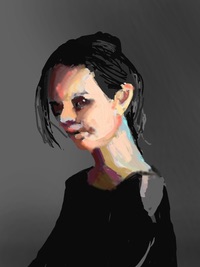How To

Designing Storyspace Three has required some fresh thinking about writing hypertext, especially the craft of hypertext narrative. Where do you put the links? How do you know whether the links are too plentiful or too sparse? Sure, we can point to some lousy examples – most Web writing today either ignores links or uses them to lie – but cataloging sins and exhorting the audience to sin no more is not entirely convincing. We have examples of good writing with links, too, but talking too much of that makes people envious and tetchy.
I’ve been inventing writing exercises and making an effort to actually write them out, using both familiar Storyspace features and the new sculptural techniques. One issue here is simply time: I’m finding it quite difficult to sustain more than 3,000 words/day of first draft material, even if the nonfiction is familiar ground. The fiction, well, I’m making that stuff up, so what takes so long? Damn.
A friend who is a Friend writes on Facebook: “I have enough, I do enough, I am enough.” You’ve got to envy that. I can’t imagine what #2 would feel like.
There’s a lot of literature that tells people How To Write. There are MFA programs and workshops and English departments and Comp Lit. There are plenty of books about books, many of them good. There are shelves upon shelves of How To Get Published and Write Best Sellers, and some of those stink of the confidence game but not all of them do.
There’s not a lot of literature about writing with links.
For example: imagine a long dialogue. The scene is dramatic and consequential: revelations will be made, minds will be changed.
Now, divide the dialog into many shorter exchanges, as you might present them for reading on a small screen. Link them in sequence. This is easy enough, though someone might ask “How long should the passages be? How do I tell if this one is too long, or that one is too short?” and, if they do ask, I can’t recall a single paper in the twenty-seven year history of hypertext that will help them.
But maybe no one will ask.
Now, let’s change that sequence. Specifically: assume that if you were there, holding a microphone behind the arras, you would have heard the first sequence. But that’s not the way we’re going to tell it. Instead, we’re going to start with the first big revelation – lead with the news – and then circle back to explain how we got there, and then talk about what came later. If you like, you can add a framing story: we’re telling the grandchildren what was said, or we’re telling the jury, or we’re telling our friends as we sit around on the deck of our yacht, becalmed in the Thames. You can rewrite transitions, but if you change dialogue you probably want to change it in both places. (Or, perhaps someone misspoke or someone else misheard? Perhaps our narrator is not to be trusted? Hello, Mr. Rashomon -- grab a seat and what’re you drinking?)
Now you think you’ve done the assignment, but you’re just getting started. Figure out ways to cross from one telling of the story to the other, and figure out ways to get back. Do not step outside the boundaries of the fields we know: magic and lyric, fugue and insanity, noise and nonsense and contradiction are all very nice and I’m sure you do them very well, but let’s keep this simple. Just make it possible to start either sequence and to wind up in the other.
Finally, figure out how the initial split occurs in the story, and also write a passage – not necessarily the conclusion – which naturally follows either sequence.
It seems to me this is the sort of thing hypertext writers ought to know how to do. It’s the sort of thing writers, period, ought to do in their sleep. Do we have good models? Where?

I can’t draw, but it’s fun to try – in part because I’m not good at it, and because drawing and painting require thinking about the thing rather than the symbol of the thing, and software design is always about those symbols.
There’s an iOS called Sktchy where people upload selfies and draw each others’. It’s an interesting mix: some school children, some art school students, some pro illustrators who are doing finger exercises or want to pin down some practical details. (If you want to draw ten Thai faces, or twenty colors of blonde, this is the place.) A lot of the discussion is formulaic or sentimental, but sometimes it's unexpectedly good.

So, Leigh V’s photo and my sketch. There’s stuff we can talk about. Some of it’s just ineptitude – bad draftsmanship, eyes that are pretty much symbolic, a lack of conviction about the neck, all stuff that deserves a red pencil but that’s pretty much only interesting in terms of “don’t do that if you can help it.” But there are other things, too. The color choices are not harmonized but I think some of them work. The warm shadows aren’t there in the world but they’re interesting, and the cerulean on Leigh’s neck isn’t there either but it looks right in the image. The exaggerated shadows work, too, more or less; some of the drafting errors might actually help, and if they're errors and not intentionally painterly touches, well, that’s why it’s called the intentional fallacy.
Leigh’s comment was “This remind me of Francis Bacon. But, you know, without the tortured screaming and slabs of meat.” And that’s generally where I meant to go, though maybe more Pearlstein or Freud than Bacon. But that’s an interesting conversation, too.
But we seldom have these conversations about hypertext writing.
The 2015 Coover Prize for Electronic Writing went to Samantha Gorman and Danny Cannizzaro for PRY. Sandy Baldwin won the Hayles prize for criticism for “The Internet Unconscious: On the Subject of Electronic Literature”.